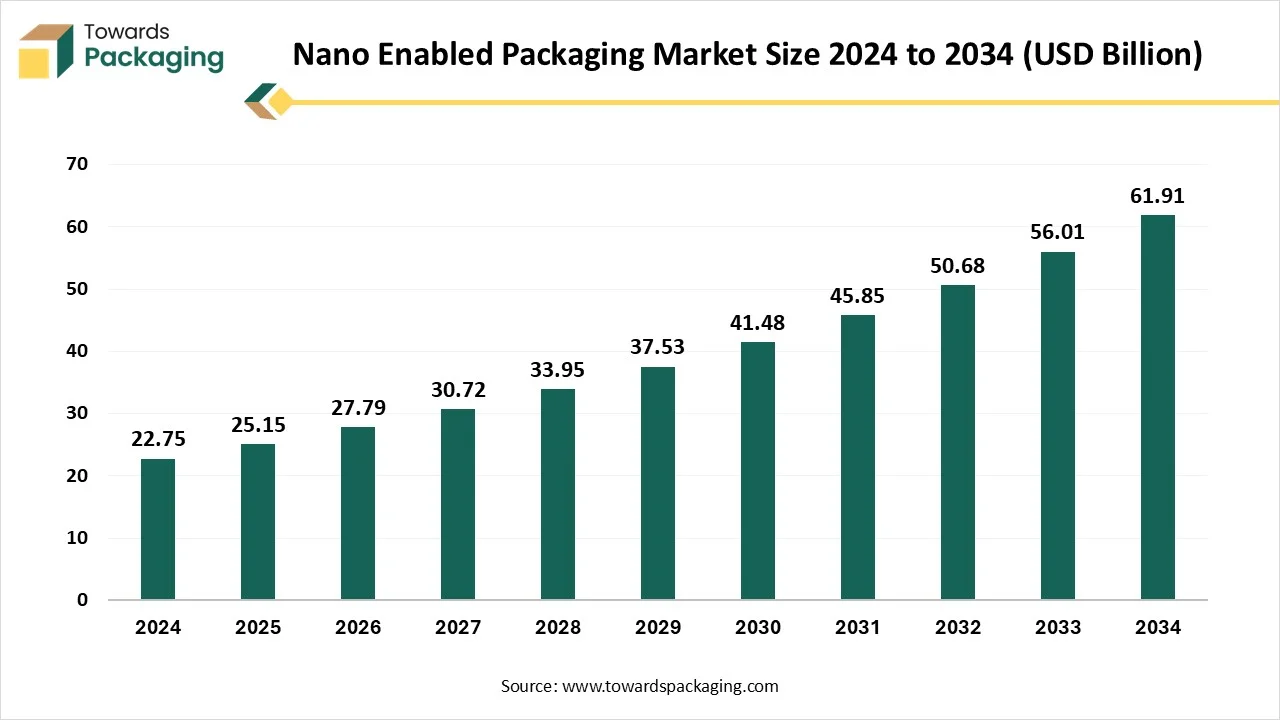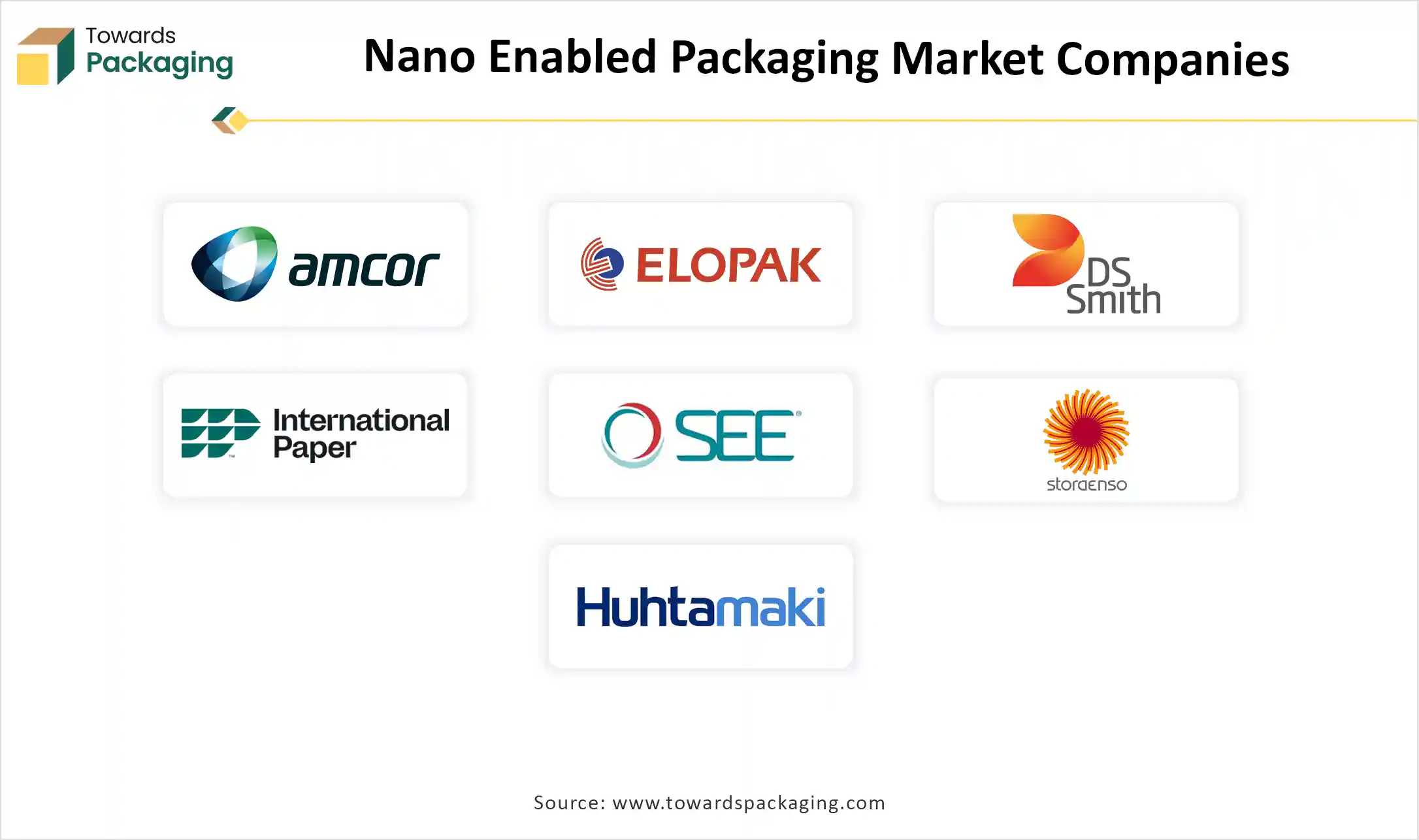The nano enabled packaging market is expanding rapidly, rising from USD 25.15 billion in 2025 to USD 61.91 billion by 2034 at a CAGR of 10.53%, driven by enhanced shelf-life requirements, antimicrobial properties, and active packaging adoption. This research covers global trends, material and type segments, end-use breakdowns, property and application insights, along with detailed regional analysis across North America, Europe, Asia Pacific, Latin America, and the Middle East & Africa. It includes company profiles of major players like Amcor, DS Smith, Smurfit Kappa, International Paper, Sonoco, and Tetra Pak, plus value chain structures, supply chain flows, manufacturing capabilities, and global trade data influencing the market landscape.

| Metric | Details |
| Market Size in 2024 | USD 22.75 billion |
| Projected Market Size in 2034 | USD 61.91 billion |
| CAGR (2025 - 2034) | 10.53% |
| Leading Region | Asia Pacific |
| Market Segmentation | By Material, By Type, By End Use, By Property, By Application and By Region Covered |
| Top Key Players | Amcor, Elopak, DS Smith, International Paper, Smurfit Kappa Group, Sealed Air, Smurfit Kappa |
AI is transforming the nano-enabled packaging by enhancing the design process, manufacturing process, maintenance systems, supply chain optimization, effective inventory management, demand forecasting, product tracking, and monitoring. All these processes evolved to the next level because of AI integration and made the operations highly effective and fast-paced. Various suitable material combinations are discovered using the AI models. Automation in manufacturing is providing the utmost precision and cost effectiveness.
The integrated sensors and software tools powered by AI provide timely maintenance-related updates and notifications. AI-driven tools are highly effective in supply chain management as they provide real-time tracking of shipments and optimized routes for smoother transportation. By analyzing the historical data, the intelligent systems predict valuable key insights for making informed decisions regarding production and inventory management.
For instance, Amul has an AI system developed by IBM, which provides real-time data about the market demand and availability of raw material, because Amul is a dairy product brand dealing with milk a highly perishable item the precise data helped Amul to take decision which helped them to sustain and stay profitable even during a un precedented disaster like Covid-19 where there was no order and complete unpredictability and chaos.
This power of AI integration in businesses has completely changed the game due to the massive ability to analyze data and provide valuable insights, which can change the business situation completely.
Continuous Advancements in Nanotechnology Driving the Market
Various technological advancements in the nano-enabled packaging have opened a new horizon for the food packaging and pharmaceutical packaging industry, as it has enhanced the packaging quality, safety standards many times compared to the traditional packaging solutions. Nanocoating, nano sensors, and nanoencapsulation, these new technologies have transformed the packaging industry in various ways. Nanocoating inside the packaging is highly impactful in food preservation due to its antimicrobial, anti-reflective, and dirt-repellent properties. Nano sensors are helping in monitoring microbial growth, temperature, and humidity, detecting chemical contamination, etc. Time and temperature indicators, freshness indicators, and integrity indicators are a few highly used nano sensors in the packaged food industry. This technological advancement is the key driving factor in the nano-enabled packaging market.
Environment and Potential Health Risks, Regulatory Hurdles, and Need for Improvement in Testing Methods
With so many advantages, there are several challenges that the industry has to deal with the nano-enabled packaging. The risk of nanoparticles getting mixed with the food can have toxic effects on the food. Which can raise major health-related concerns. This particular issue is completely uncompromisable. Due to this, the regulatory hurdles are very particular and stringent. The currently available testing methods lack consistency and accuracy in results. So there is a need to develop highly accurate and standard testing methodologies. As the nano technology is a very recently evolved technology, its adverse effects on health and the environment are still under observation.
Growing Demand for Packaged Food & Beverages with Sustainable Packaging Solutions
In recent times, the demand for packaged food items has increased very rapidly due to various reasons, and food packaging solution provider companies are continuously looking for advanced solutions for increasing food shelf life and preserving quality. Nano-enabled packaging solutions are seen as the potential solution for this growing demand. While being an effective solution, various biodegradable nano-enabled packaging solutions are catching attention in the packaging industry, and the demand is increasing, considering the governmental push for sustainable packaging solutions.
The unique features of polymers, like effective barrier properties, lightweight, and high flexibility, make them a highly used material in the nano-enabled packaging market. Newly discovered biodegradable polymers made from plant-based material are in high demand due to their sustainability, packaging, and being safe for food packaging.
Carbon nanotubes are expected to be the fastest-growing sub-segment in the material segment of the nano-enabled packaging market. the reason behind this is the unique offerings by the carbon nanotubes, like high strength, excellent thermal conductivity, and electrical conductivity. All these properties make it a very suitable material for various use cases. Active packaging solutions incorporate carbon nanotubes in many packaging solutions.
Flexible packaging dominated the nano-enabled packaging market as it has a wide range of applications in the nano-enabled packaging market. enhanced barrier properties, antimicrobial properties, high strength, durability, and flexibility, incorporation of all of which make it a highly versatile packaging type in the nano-enabled packaging market. Active packaging is expected to be the fastest-growing sub-segment in the type segment. This growing demand is expected due to the various advanced applications of active packaging for various packaged food items.
The food and beverages segment is dominating the nano-enabled packaging market, considering the increasing demand for packaged food items. The enhanced packaging quality due to the nanotechnology integration in packaging provides advanced packaging solutions. The antimicrobial properties and active ingredients, like oxygen scavengers, prevent the food from spoiling and increase the shelf life. A significant amount of growth is expected in the pharmaceutical sector as the nano-enabled packaging is offering the utmost quality of safety and protection to the pharmaceutical ingredients.
The Antimicrobial segment is showing significant growth due to the increasing requirement for effective food items packaging to enhance the shelf life and preserve the food quality for a longer period. Barrier property also shows notable demand in the Nano-enabled packaging market, as the quality barrier protection is in high demand for packaging protection.
Enhanced Shelf life is an extremely critical application in the packaging industry, as it reduces food spoilage in a short time and provides quality food to the end consumer. high-quality, expensive drugs are very sensitive to the external environment. It is essential to provide them the high a high-quality packaging solution which will protect the quality and keep it intact for a longer period. Anti-counterfeiting is in high demand due to the rising risk of counterfeit products, particularly in the case of pharmaceutical drugs, the counterfeiting can be very dangerous and can have very severe consequences.
Asia Pacific led the nano-enabled packaging market in 2024. The Asia-Pacific region has a massive population and a huge demand for food and pharmaceuticals requires a large amount of packaging solutions. China and India hold a significant share in this region, and with continuous technological advancements, the market is growing rapidly. Sustainable packaging, active and intelligent packaging, is in high demand due to environmental concerns and dealing with the rising counterfeiting issues.
North America is showing demand for nano-enabled packaging due to the increasing food and beverage industry, the pharmaceutical industry, electronics industry are also showing demand in the market. Continuous innovation is ongoing in this region to develop better packaging solutions using nanotechnology in packaging. Smart packaging solutions are used in the market to improve the efficiency of operations. In between all these, the focus on sustainable packaging is paramount, and various methods are under implementation to ensure the use of eco-friendly packaging solutions.
The increasing demand for sustainable packaging in Europe is making it the leading market for nano-enabled packaging solutions. Various food packaging and pharmaceutical companies are investing in nano-enabled solutions, considering their effectiveness in enhancing the shelf life of the product. Keeping it fresh for a longer duration and preserving the quality.
Latin America, the Middle East, and Africa are expected to show increasing demand in the upcoming years, considering the advanced packaging solutions offered by the integration of nanotechnology and a significant focus on sustainable packaging solutions developed using the latest technology.

By Material
By Type
By End Use
By Property
By Application
By Region Covered
December 2025
December 2025
December 2025
December 2025